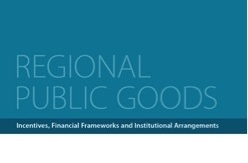
Regional public goods (RPGs) can be summarised as goods or resources that can be shared by people across countries in a more or less non-rival, non-excludable way. RPGs can support developing countries to achieve higher economies of scale in market size and thereby contribute to the development of a region, but also to regional peace and stability. Yet, due to political issues and market failures, such as the dilemmas that RPGs create due to presence of positive or negative externalities
The Collaborative Africa Budget Reform Initiative (CABRI) has an interest in RPGs because of their impact on the public finances of countries in Africa. This is why CABRI (with the support of the African Development Bank) has conducted research on a number of RPGs in Africa in order to examine the benefits and challenges which result in their provision from a financing perspective. At CABRI’s 3rd Africa Policy Seminar in Cape Town senior officials from 14 African countries and representatives from various international organisations met to examine Regional Public Goods in the African context, the incentives to enter into such projects, the institutional arrangements that enable their provisioning as well as the available financing frameworks.
Collaboration on RPGs is not an easy task. An example of the challenges is a railway line between Malawi and Mozambique which needs maintenance work in a swamp area on the Mozambique side. This railway connects Malawi to a Port and is therefore of more importance to Malawi than to Mozambique. Yet, due to the lower importance of this railway link to Mozambique, the repair work on the railway line is not undertaken and Malawi struggles with the resulting negative externalities.
Key lessons
Regarding the implementation of Regional Public Goods Projects, the key points raised during the discussions on project design include the following:
(1) Commitment: A shared purpose as well as a long term commitment of participating countries are the basis for any regional public cooperation;
(2) Institutional foundation: In order to have a sustainable collaboration, the necessary institutional arrangements need to be created in a robust and flexible manner. It is also important to reassess the circumstances in the course of the project in order to explore whether contributions need to be weighted differently, or partnerships possibly redefined;
(3) Capacity: Sound project design includes ensuring that financial mechanisms are carefully scrutinised beforehand in terms of the capacities of the involved parties in order to ensure regulation and also enforce the implementation of regional projects.
(4) Coordination of projects: While the different nature of infrastructure needs to be taken into account, the coordination of projects can result in higher cost efficiency (e.g. jointly coordinating the construction of a cross-boundary road and an underground cable running next to it).
(5) Strong leadership: Most times RPGs are not of equal importance to all countries involved. It can, however, still be useful for a strong country or institution to take a leading role and support a weaker country (even if this country can draw a greater benefit from the provision of a public good), as the entire regional collaboration on an RPG might otherwise be undermined.
Partnership solutions for regional projects
Public Private Partnerships (PPPs): When public and private sector aims are aligned, the benefits of collaborating become obvious: strong private sector participation can improve the execution of regional public projects. The Maputo Development Corridor that links South Africa and Mozambique is a good example for this. The private sector can also be instrumental in providing risk capital, as project financing from debt alone does not provide equity and is not sustainable. What is important to bear in mind is that while the vision of providing a public good in the public sector mostly represents a long-term goal, the private sector interest may be limited in time and provisions need to be made for an eventual end of such a partnership. PPPs can, indeed, go well, but the enforcement of agreements on the international level needs to be carefully thought through.
Regional Banks: In order for regional initiatives to take off, regional banks need to be brought to the floor as main actors for the financing of RPGs. Regional banks are especially important when it comes to the initial project phases (feasibility studies etc.), when return on investments might be unclear and therefore still unattractive for private sector investors. This also means that the capacity of regional banks needs to be strengthened, both in terms of financial means to support regional initiatives and capacitating staff through training regarding questions such as: what kind of financing structures to develop, which of the partner in the RPG project will receive the funds etc.
Creative regional solutions
One example for creative financing options that can be learned from is the Africa Risk Capacity (ARC), a new mechanism that has been created from collaboration between the African Union and the World Food Programme. The ARC is not a pure regional public good, but it is an example of a club good aiming towards reducing the risk of negative externalities that arise from natural disasters. It is a risk financing facility that provides the possibility for member governments to access contingency funds as a potential disaster response with the objective to avoid governments‘ redirecting resources originally planned for other activities.
Though co-operation on Regional Public Goods is a challenging endeavour, cross border-collaboration has clear success stories. One of these is the river blindness control work in sub-Saharan Africa: the African Programme for Onchocerciasis Control (APOC). The APOC is generally considered as a good practice example, where, despite internal and cross-border political conflicts, the programme continued to work and has substantially contributed towards combating Onchocerciasis in Africa.